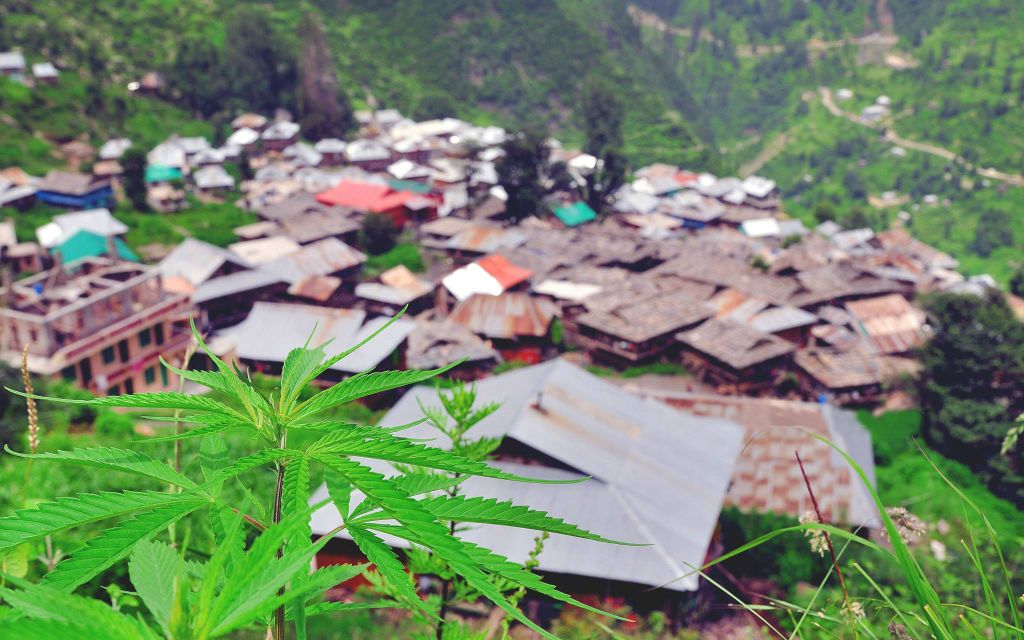Malana
Malana is a historic Indian hamlet in the Himachal Pradesh state. This remote settlement in the Malana Nala, a Parvati Valley side valley to the north-east of Kullu Valley, is cut off from the rest of the world. The peaks of Chanderkhani and Deo Tibba cast a long shadow across the settlement. It is located at a height of 2,652 metres (8,701 feet) above sea level on a desolate plateau on the side of the furious Malana river. Malana has its unique way of life and social structure, and people adhere to their traditions religiously.
Malana has been featured in a number of films, including Malana: Globalization of a Himalayan Village and Malana, A Lost Identity. There are roughly 1700 speakers of the autochthonous language Kanashi, the traditional language of the Malana population. According to the 1961 census, there were 563 language speakers, although today’s Malana population is at least three times more than it was 40 years ago. The most frequent way to get to the village is to take a cab or a bus from Jhari. One stop before Malana. Roads have been built up to the Malana Village hiking gate.
Malana is well-known for its ‘Malana Cream,’ a product derived from cannabis indica discovered in Himachal’s Parvati Valley.

Malana, a historic town set among Himachal Pradesh’s high mountains, is well-known as the ideal holiday spot for hipsters. The area is surrounded by lush, green trees and breathtaking landscapes, making it ideal for individuals who appreciate nature in its purest form. The village is bounded on the north-east by the Parvati valley and on the other by the Kullu valley, with the peaks of Cahndrakhani and Deotibba casting a shadow over the small paradise of India.
Apart from its natural beauty, Malana is also noted for its distinct lifestyle and social structure, which the residents largely adhere to. Their clothing, the food people consume, the festivals they celebrate, the manner those festivals are celebrated, and other aspects represent the lively culture and tradition that is unique to the area. This ideal vacation spot is located at a height of 2,652 metres, or around 8,701 feet above sea level. There is so much beauty hidden in this town that several films have been created about it, showcasing the glories that Malana includes.
Kanashi is the traditional language spoken in Malana. Aside from that, there is a lot of history behind the presence of this lovely area. According to local folklore, the respected sage Jamlu Rishi lived here and is credited with establishing the norms, customs, and culture of Malana, among other things. Locals even believe that Malana exemplifies one of the world’s oldest democracies, complete with a well-established parliamentary system. Malana is said to have had great regard during pre-Aryan times.
The confluence of the Beas and Parvati Rivers may be viewed at Bhuntar, right underneath the bridge where the road to Parvati Valley departs from the highway. The air is clean and has a pleasant scent of nature. It’s a tiny route, and the bus sways from side to side, providing the tourist with some terrifying yet unforgettable moments. The bus first stops at the unremarkable town of Jari, and Malana is still quite a distance away.
A isolated settlement in Malana Nala, a minor valley of the Parvati Valley, is cut off from the rest of the world. It is located in the Kullu district and is known as Malana or the Malana Village. It is a site for those seeking spiritual advice because of its rich culture and religious beliefs, as well as numerous feelings entrenched in the past. This location is also ideal for adventure seekers, as the road to Malana is well-known for hiking.
How To Reach Malana
Three mountain crossings link Malana to the Kullu valley. It is accessible through Parbati Valley, Manikaran, following a 10-hour journey over the 3180-meter-high Rashol Pass, or through Nagar over the 3600-meter-high Chanderkhani Pass, which is a two-day trip. The quickest and most direct route to Malana is through the settlement of Jari, which is connected to the Kullu valley. Malana, which is only 12 kilometres away, is a six-hour easy and scenic walk away. The Malana nallah stream and the beautiful waterfalls are an added bonus. Jari is 13 kilometres from the nearest airport, which is located in Buntar.
Places to Visit Malana:
The temples in Malana, the Jamadagni Temple and the Shrine of Renuka Devi, are the village’s main attractions. Built close together, they are well renowned for the worship of many gods and goddesses who are highly adored by the people, and great care is taken to preserve them. The trip to Malana is embellished by beautiful deodar foliage and a glimpse of the Malana Dam, which energises people from time to time.
A hundred-house cluster exists in the Kullu and Manali valleys below the Chanderkhani Pass, at an elevation of 276 metres above sea level. The type of settlement that may be found across the valleys. However, there is something unique about this cluster of stone rooftops. This is Malana, or the Malana Republic, as the village is called in the Kullu valley. The hamlet of 1000 tribals has an impeccable system of self-government, complete with its own lower and higher courts, President, and Prime Minister. They are a distinct tribe with distinct customs that live in a realm of self-created autonomy within the Himalayas and claim Greek ancestry.
Best Time To Visit Malana
The town enjoys a severe climate due to its position in the Himalayan area. Summers are the ideal months to visit because it is easily accessible. The optimum time to visit is from early May until late August. This is the date of the summer festival.
In the month of February-phalgun, the Harlala mask dancing event is held. It is a time when everyone takes a bath and a group of individuals dressed entirely in cannabis leaves and demon-like masks dance about the houses spreading cow manure, which also acts as insulation against the cold. The procession commemorating Emperor Akbar is another fascinating feature of the celebration.





